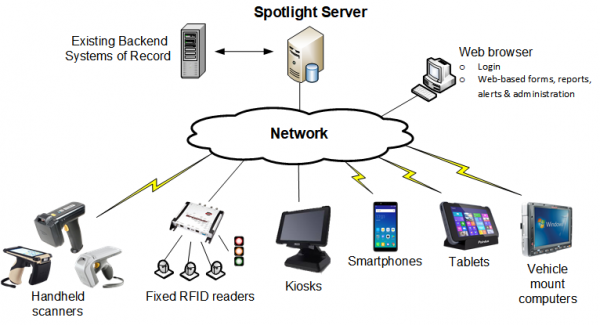All turn-key solutions delivered by S3Edge are based on and include S3Edge’s Spotlight software. Spotlight allows S3Edge to quickly and cost effectively develop, deploy and support RFID and barcode tracking systems that meet the specific needs of our client customers. It is reusable software that S3Edge has developed which is customize and extend with client-specific data and business logic by S3Edge’s professional services staff for each deployment. A license for S3Edge’s Spotlight software is included with each deployment.
Network Architecture of a Spotlight Solution
The physical network architecture of a typical Spotlight deployment is shown in the figure to the left. It includes a central Spotlight server and a set of network-attached devices that perform the actual scanning functions. The remote devices include dedicated handheld scanners, kiosks, smartphones, tablets, vehicle mount computers and network attached RFID readers.
The Spotlight server interacts with and controls the remote devices used to scan items as they move through the system. Spotlight Mobile software is installed runs on the remote devices and controls the actually scanning hardware (RFID or barcode). Firewall-friendly protocols are used to connect the server and the remote devices so the server may be physically located on premise at a client site or may be hosted on the Internet.
The Spotlight server is also typically connected to and interacts with existing backend systems of record such as a enterprise resource planning system, manufacturing execution system, warehouse management system and others. End users login and interact with the Spotlight server using a web browser with a set of dashboards and forms implemented by the Spotlight server web site.
Spotlight Server Software
The software “stack” installed on the Spotlight server is shown in the figure to the right.
The central Spotlight server contains all the information and business logic associated with the items being tracked. The Spotlight server also interacts with and controls the remote devices that perform the actual scanning functions. End users login and interact with the Spotlight server using a web browser to access a set of web-based dashboards and forms implemented by the Spotlight server.
The web-based dashboards are configured and customized for each client engagement with information specific to each client deployment. The dashboards and forms are implemented as a “single page application” (SPA) in TypeScript. Spotlight’s roll-based security system determines the information and capabilities that each authenticated user can access.
In most installations, Spotlight server also connects with and exchanges information with one or more existing back end systems of record. Several different technologies are available to implement this connection depending on the capabilities of the existing systems. This includes web services, database translation tables, flat file data exchange or custom APIs specific to the backend system.
Spotlight Mobile Software
The software “stack” installed on the mobile devices is shown in the figure to the left.
Remote devices control the RFID and barcode scanners used to scan items as they move through the system. Some examples if the types of remote devices supported include dedicated handheld barcode and RFID scanners, smartphones, touch-screen kiosks, tablet PCs or fixed network-attached RFID readers.
End users interact with the remote devices using a set of applets that are developed unique for each client customer. For example, they typically include the error-proofing and business logic needed to detect and immediately report material processing errors when they occur. S3Edge professional services staff implement the applets in TypeScript as a “single page application” (SPA) that’s installed and run on the mobile devices.
Remote devices connect and communicate with the central Spotlight server using secure firewall-friendly protocols. The devices can therefore connect with the central Spotlight server either over a corporate network or via the Internet in the case scanning devices are installed in geographically remote locations.
A local database on the remote devices is used to cache the item and device configuration information needed to allow remote devices to operate autonomously from the Spotlight server when connectivity to the server is temporarily not available. When connectivity to the server is restored, the mobile devices and server re-synchronize their perspective databases. This feature allows remote devices to continue to operate even when network connectivity is not reliable or when the server is taken down temporarily for maintenance.
Spotlight Process and Data Flow Architecture
The process and data flow architecture for a typical Spotlight deployment is shown on the right.
Mobile devices control the RFID/barcode scanning hardware and run applets developed by S3Edge professional services staff that implement client-specific business logic and workflows. A local database on the mobile devices contains an operational “cache” of item and device configuration information to allow the mobile devices to operate autonomous from the central server for a time when connectivity to the server is temporarily not available.
The mobile devices are network connected to the central Spotlight server using firewall friendly protocols and APIs including HTTPS, Web services, and WebSockets. End users interact with the central Spotlight server using a web browser to login and access web-based dashboards and forms. Browsers connect with the central Spotlight server using Webs services API’s, WebSockets and HTTPS.
The Spotlight service is implemented as an IIS web site. It uses a Microsoft SQL Server database to store all item, device and configuration information and implements the business logic associated with a specific client’s tracking system. The External Connection API Service provides connectivity to any existing backend system of record required. There are a number of different connection technologies that can be used to accomplish this including web services, database translation tables, flat file data exchange or custom APIs.





